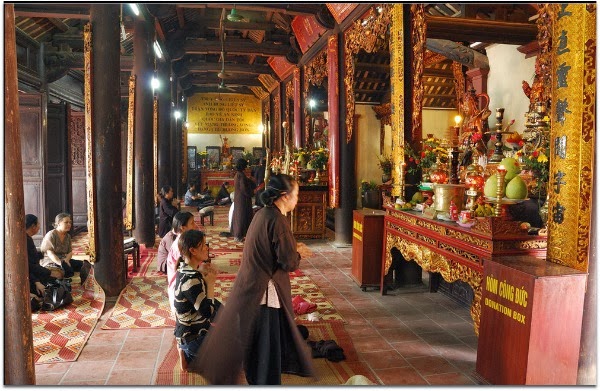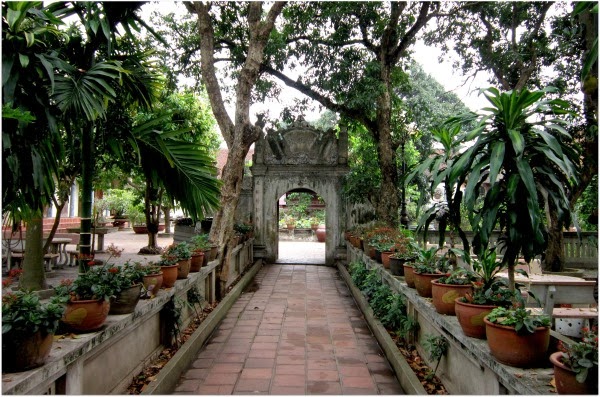THINGS TO KNOW BEFORE YOU GO - HANOI (Part 2)
If each bridge span is the sequence of the present – future, Thang Long citadel’s pagodas will be a sacred place to keep the national cultural heritages in Vietnam. This time, "Vietnam Here and There” will help you experience the pagodas’ beauty in Hanoi.
PART 2: PAGODAS IN HANOI
Living in Hanoi, you sometimes forget simple living values around. One day, your feet are so tired because of a busy life; you will regretfully answer yourself “what’s truly value”. This is the simplest things around you. Perhaps, each one has their own feeling whenever they visit Hanoi – the 1000-year civilization’s land. Here and there, we see a simple antique, a cultural value and an ancient Thang Long citadel.
In previous part, you knew about bridges in Hanoi. However, leaving much impression on each tourist visiting Hanoi capital is pagodas in Hanoi and its architectural – historical values. For this meaning, let’s feel and discover an ancient Hanoi through pagodas.
In previous part, you knew about bridges in Hanoi. However, leaving much impression on each tourist visiting Hanoi capital is pagodas in Hanoi and its architectural – historical values. For this meaning, let’s feel and discover an ancient Hanoi through pagodas.
 |
| Tran Quoc pagoda |
THE OLDEST PAGODA IN HANOI
 |
| Tran Quoc Pagoda. Source: cameroonjb |
Tran Quoc Pagoda is not only considered to be the longest history in Thanglong – Hanoi, but it also is one of the oldest pagodas in Vietnam. Built in Ly Nam De Emperor (544 – 548) on the shores of the Red River, the original name is Khai Quoc pagoda. It means national founding pagoda in English.
 |
| Tran Quoc Pagoda. Source: Nir Sinay |
By the 15th century, the pagoda was renamed An Quoc pagoda meaning pacification of the realm. In 1615, people moved it to a small island on Thanh Nien Street as today because of Red River’s erosion. Restored with the largest structure in 1639, the pagoda was renamed as today.
 |
| Tran Quoc pagoda at night |
About architecture, the pagoda shows aesthetic feature of oriental architecture and keeps together landscape between sky and water. Looking sacred inside pagoda, it is simple from the outside. Like most other pagodas in Vietnam, Tran Quoc pagoda has three main sections namely Tien Duong - The Front Hall which is the first layer architecture in each pagoda, Tăng Duong - Monks’ Hall which worships dead monks in the pagoda and Thuong Dien - The Buddha Hall. These parts combine to form a traditional shape like a Chinese character. That architecture is very popular in pagoda, Vietnam. In addition, there are some buildings such as three-door gate, garden and Buddha tower in the pagoda. Each section has its own significance attaching to Buddhism principle.
 |
| The Main Hall of tran Quoc Pagoda |
The unique thing of Tran Quoc pagoda is a stupas courtyard with precious towers, typically the Lotus tower. Built in 1998, it owns a unique architecture with eleven levels and six sides.
 |
| The Stupas Tower (looking from Thanh Niên street). Source: Larpoon |
Visiting to Tran Quoc pagoda, you will find out the soul of the Thang Long citadel blending with nature. Leaving your worry behind to go the pagoda, it is the best way to relax and love your life more. There is only tranquility in your mind with a windy and spacious holy land.
THE UNIQUE ARCHITECTURAL PAGODA
 |
| Overview of One Pillar Pagoda. Source: sntssche |
It will be a big mistake unless we mention to "One Pillar Pagoda" in this topic. The unique architecture is the first impression of each tourist at the first sight. Hanoi became the capital in 1010, when one king moved from Hoa Lu - a mountainous area to the delta, which is more convenient for cultivating, trading and traffic. The king ordered to build various temples and pagodas for the new citadel.
 |
| One Pillar Pagoda |
Built in 1049 under the reign of Ly Thai To, it was in a complex consisting of a pagoda and a tower built in a square lake. The group was officially called Diem Huu (long lasting happiness) pagoda and Lien Hoa (lotus) tower, but the tower has traditionally been called the One-pillar Pagoda.
 |
| One Pillar Pagoda |
The pagoda looks like a lotus blossoming from the square lake. Its unique architecture based on the very attractive legend: in 11th century, the King Ly Thai To was very old and had no son. Therefore, he often went everywhere to pagodas to pray for. One night, he got a dream meeting a Goddess of Mercy had sitting on a lotus flower. She gave him a pretty boy. Months later, his queen got pregnant and gave birth to a male child. To repay gift from the Goddess of Mercy, the King ordered to build a pagoda like a lotus, which was supported by only one pillar.
 |
| The back of One Pillar Pagoda |
Today, there are many couple come here and pray for a child (especially a son).
Nowadays, it belongs to in Ho Chi Minh complex. This makes “One Pillar Pagoda” more sacred and beautiful. Not only does it keep the national cultural and historical value, but it also is the pride of Vietnamese people about architecture and will last forever!
THE “MÍA” PAGODA
 |
| The Stupas at Mia Pagoda |
Talking about the ancient village - Duong Lam, tourists will be delighted with not only a beautiful and friendly destination, but also about an ancient pagoda - Mia Pagoda meaning “The sugar cane pagoda” in English. Unlike other pagodas, though Mia pagoda is located in a remote and peaceful countryside, it still looks solemn and sacred.
 |
| From the entrance of Mia Pagoda |
There is no document about when it was exactly built, but there used to be a small pagoda there. In 1632, a woman, one of the king’s concubines that time, restored the Mia pagoda with the largest scale as today. Later, local people made her statue and placed in the pagoda for worshiping in order to show their respect.
 |
| The altar in the main hall of Mia Pagoda |
Mia pagoda is broadly known as an ancient pagoda having the most statues in Hanoi. There are diverse kinds of statues namely, 6 bronze statues, 106 wood ones and 174 earthen statues, which are displayed in 27 compartments to combine into a closed area.
Each statue was shaped with its own feature looking lively and harmonious in the minutest detail. The art of sculpturing in this pagoda reached at its peak.
 |
| Thi Kinh Staute in Mia Pagoda |
The “Thi Kinh” statue and 8 statues displaying into two main halls are very representative of the sophisticated sculpture in Vietnam. Thi Kinh is a good woman considered as the Vietnamese Bodhisattva. Eight statues are also 8 deities embodying 8 directions in the universe.
 |
| Buddhist Statues at Mia Pagoda |
Made of various kinds of precious woods with sophisticated patterns, the Mia Pagoda is a typical example of sculpture in Vietnamese feudalism. Through it, we might know more about how religious Vietnamese people were in the past. The Mia Pagoda has not changed much with an insecure history. It has silently lived with time and Vietnamese people there.
Pagoda is a sacred and closed calling with most of Vietnamese people in general and Hanoi people in particular. Pagoda can easily be seen in anywhere in Vietnam even a remote village. Perhaps, each Vietnamese likes going to pagoda to seek traditional values and tranquility in their minds. Truly, a hurried life is shadowing elegant enjoyments in our life. Staying in a pagoda, it is a perfect time to slow down and live honestly with yourself!
Pagoda is a sacred and closed calling with most of Vietnamese people in general and Hanoi people in particular. Pagoda can easily be seen in anywhere in Vietnam even a remote village. Perhaps, each Vietnamese likes going to pagoda to seek traditional values and tranquility in their minds. Truly, a hurried life is shadowing elegant enjoyments in our life. Staying in a pagoda, it is a perfect time to slow down and live honestly with yourself!
Read more...
If you like the article (and even if you don't), or have ideas for topics you'd like enjoyed in the next time, let me know what you think about An Insider Of Vietnam. And rest assured I have been trying to improve the coming articles’ quality.


Comments
Post a Comment